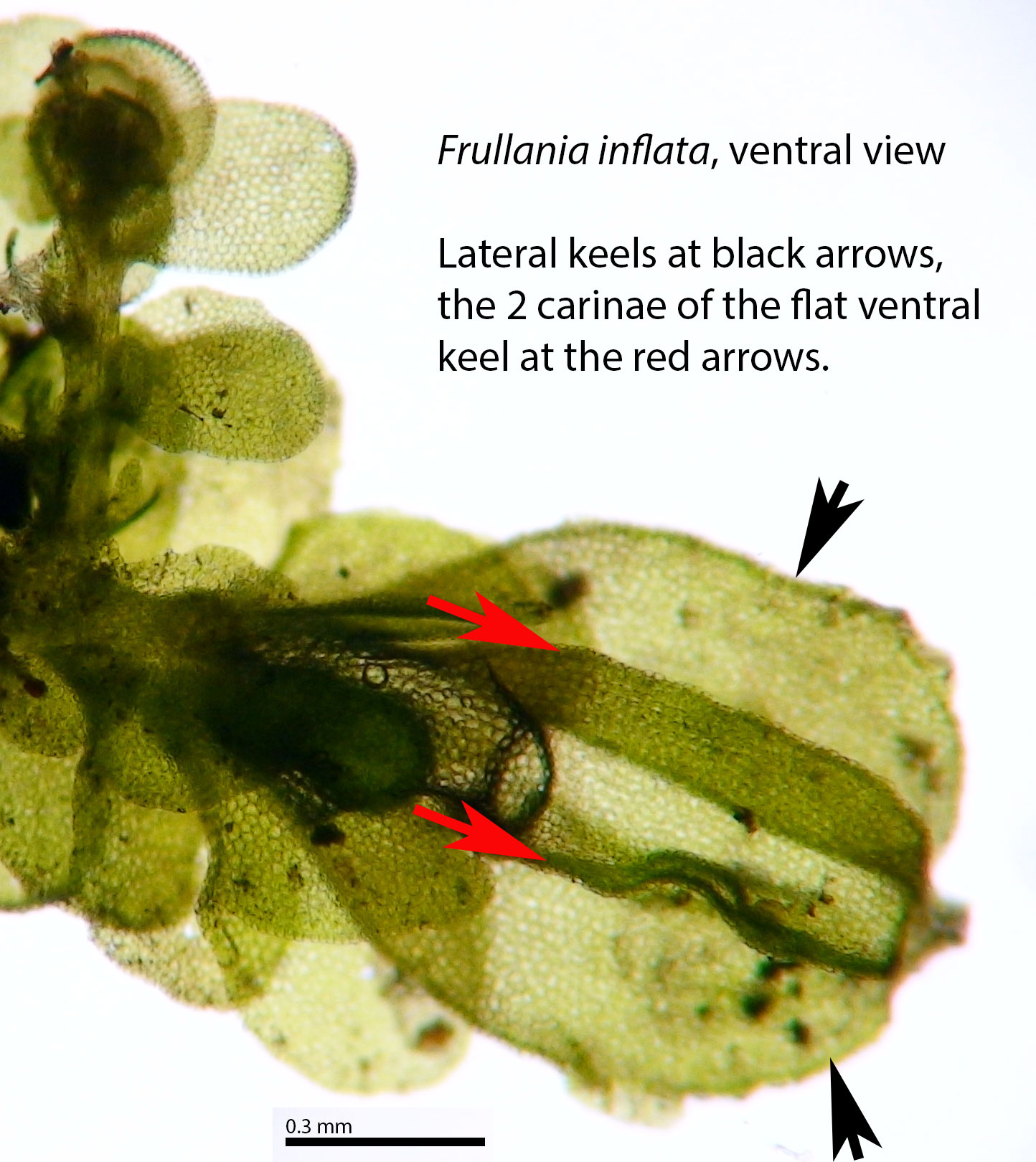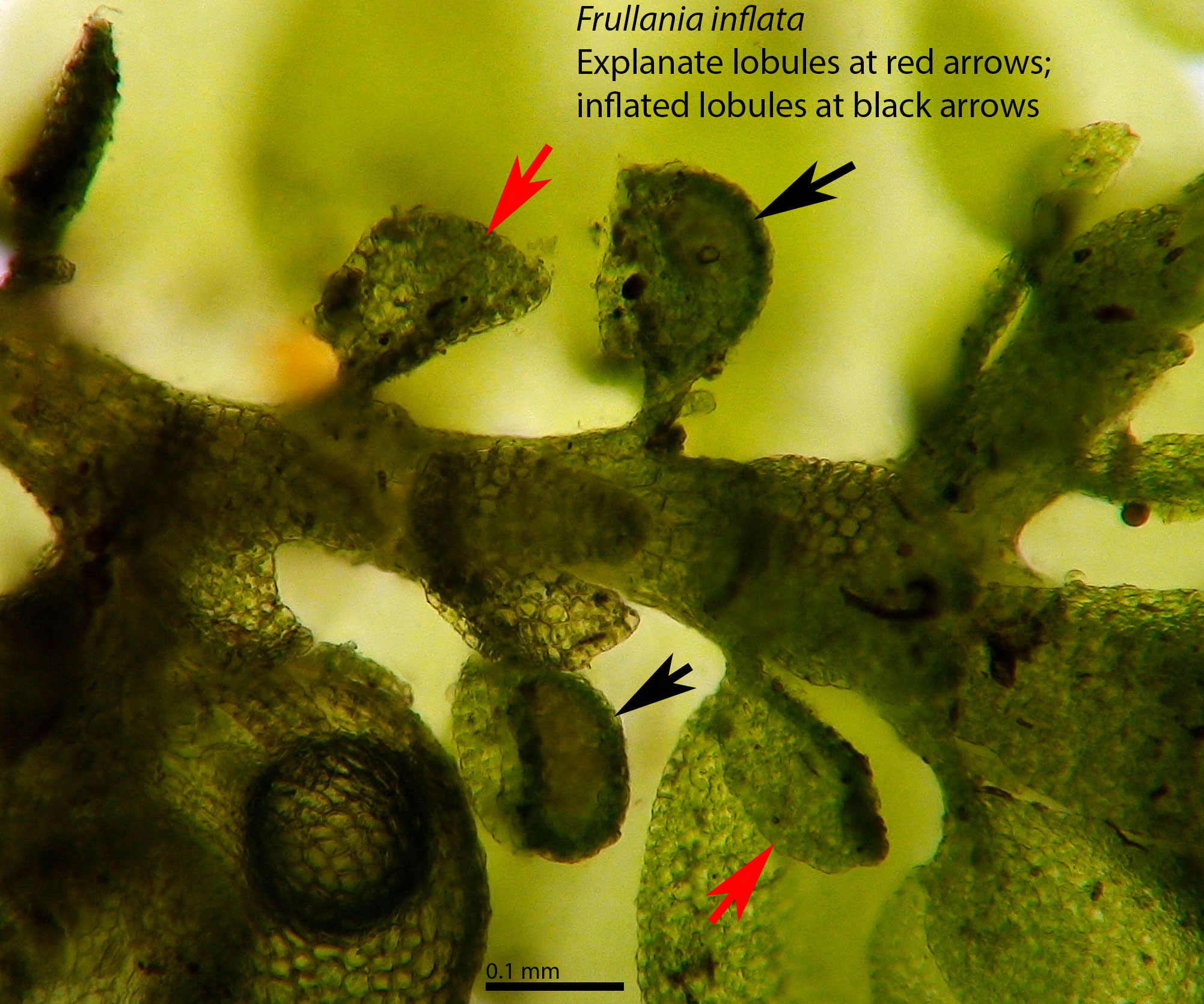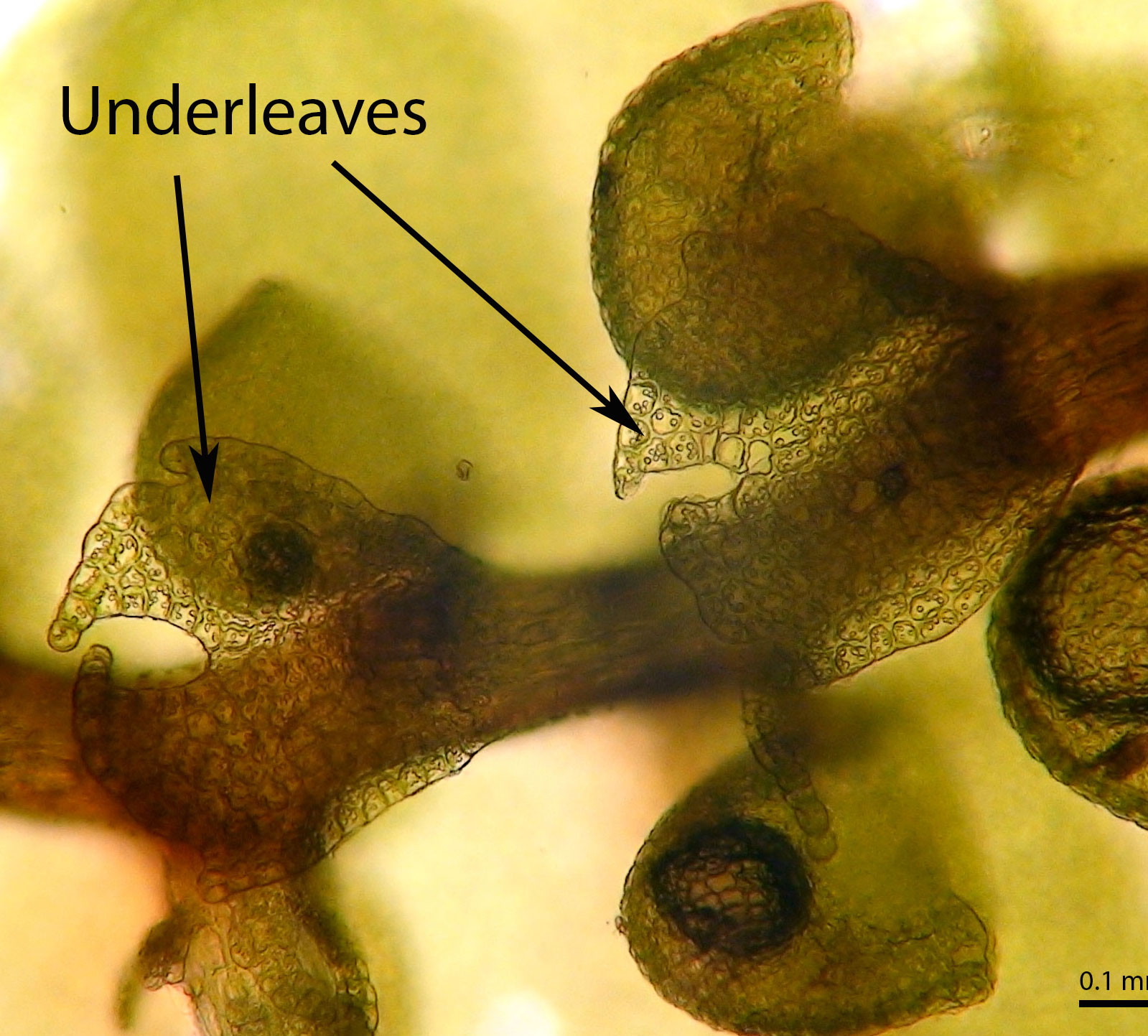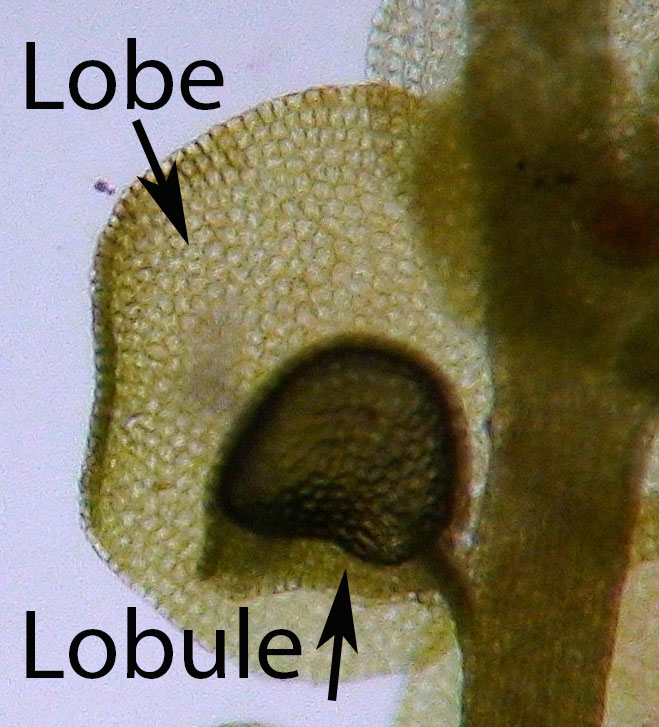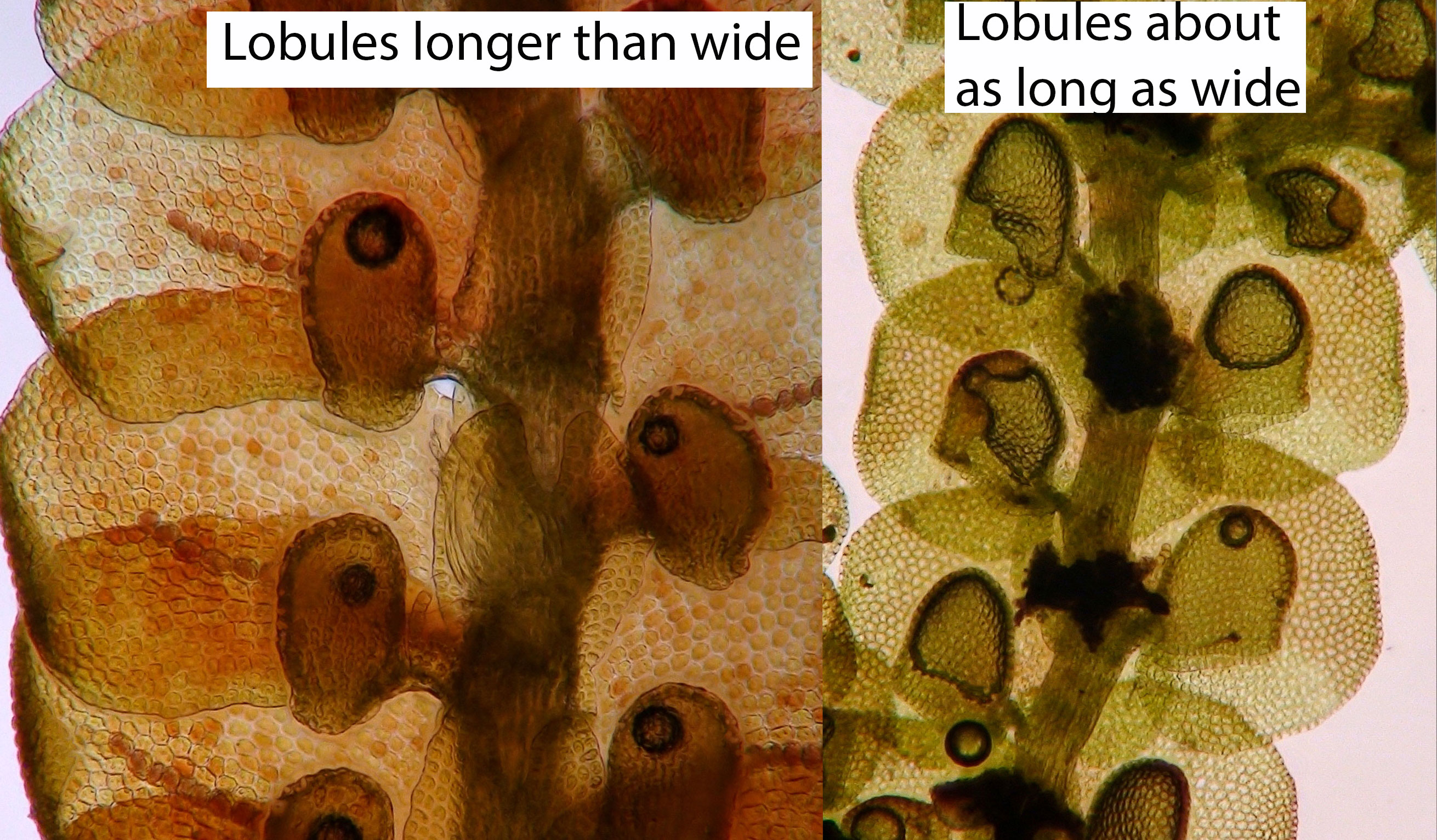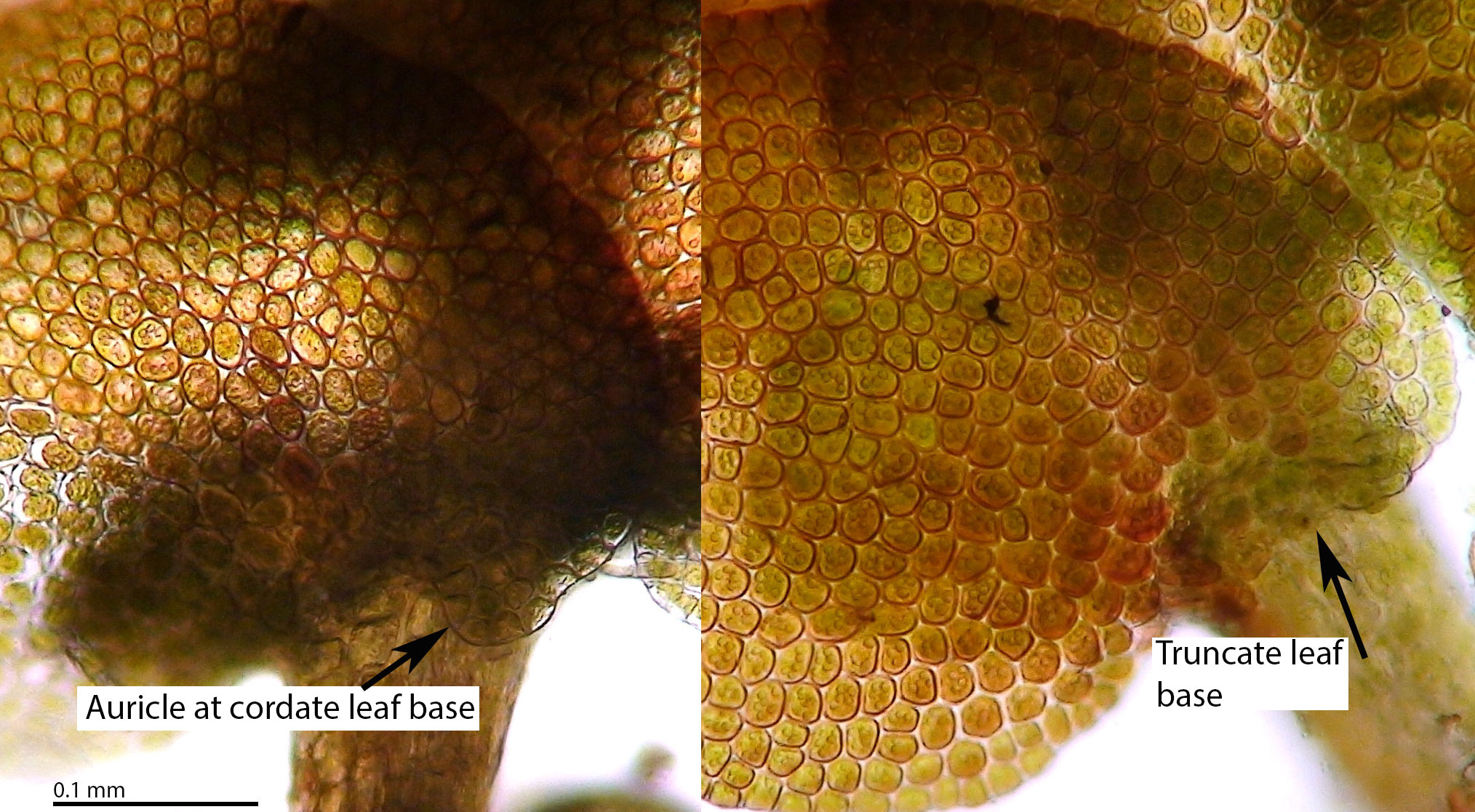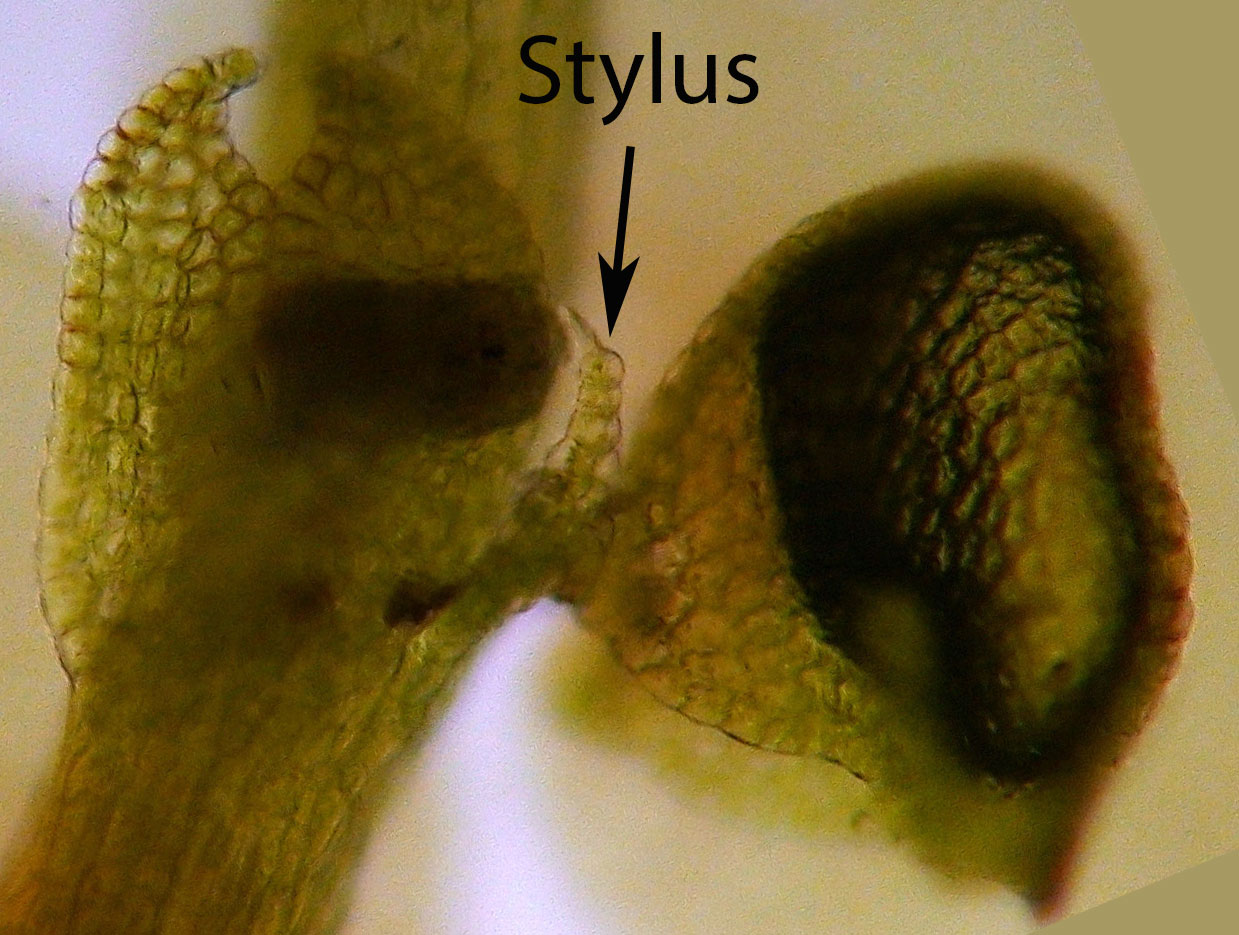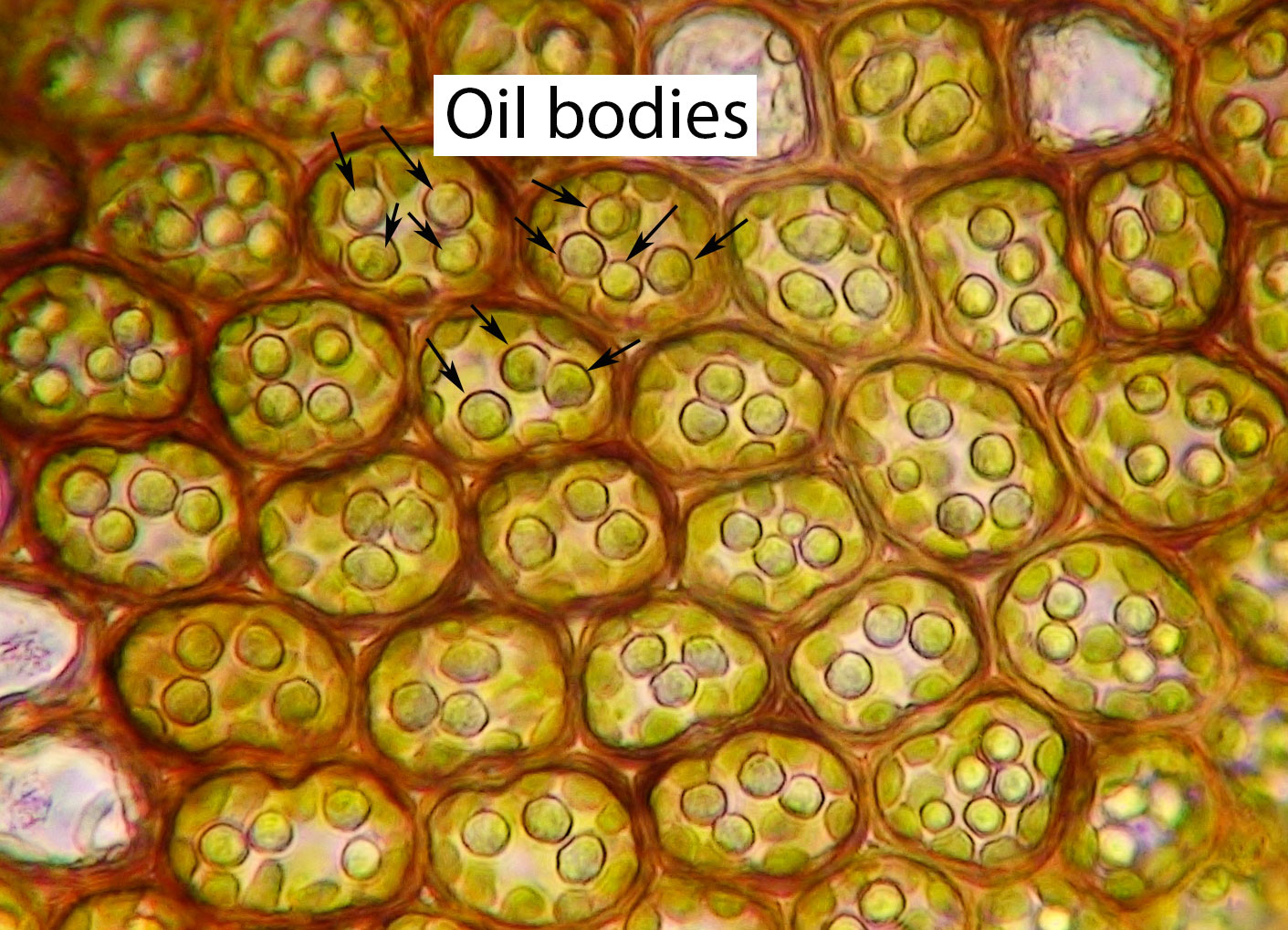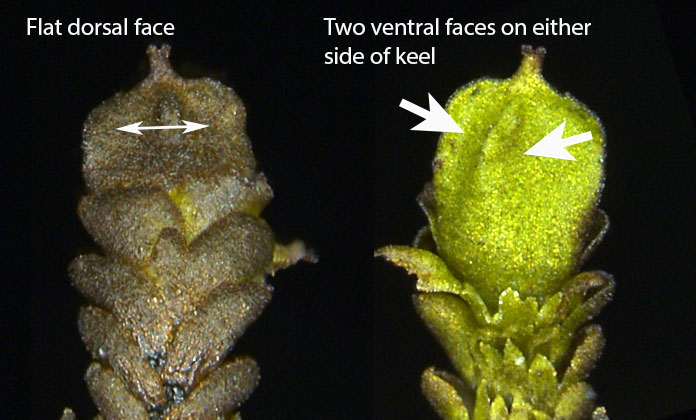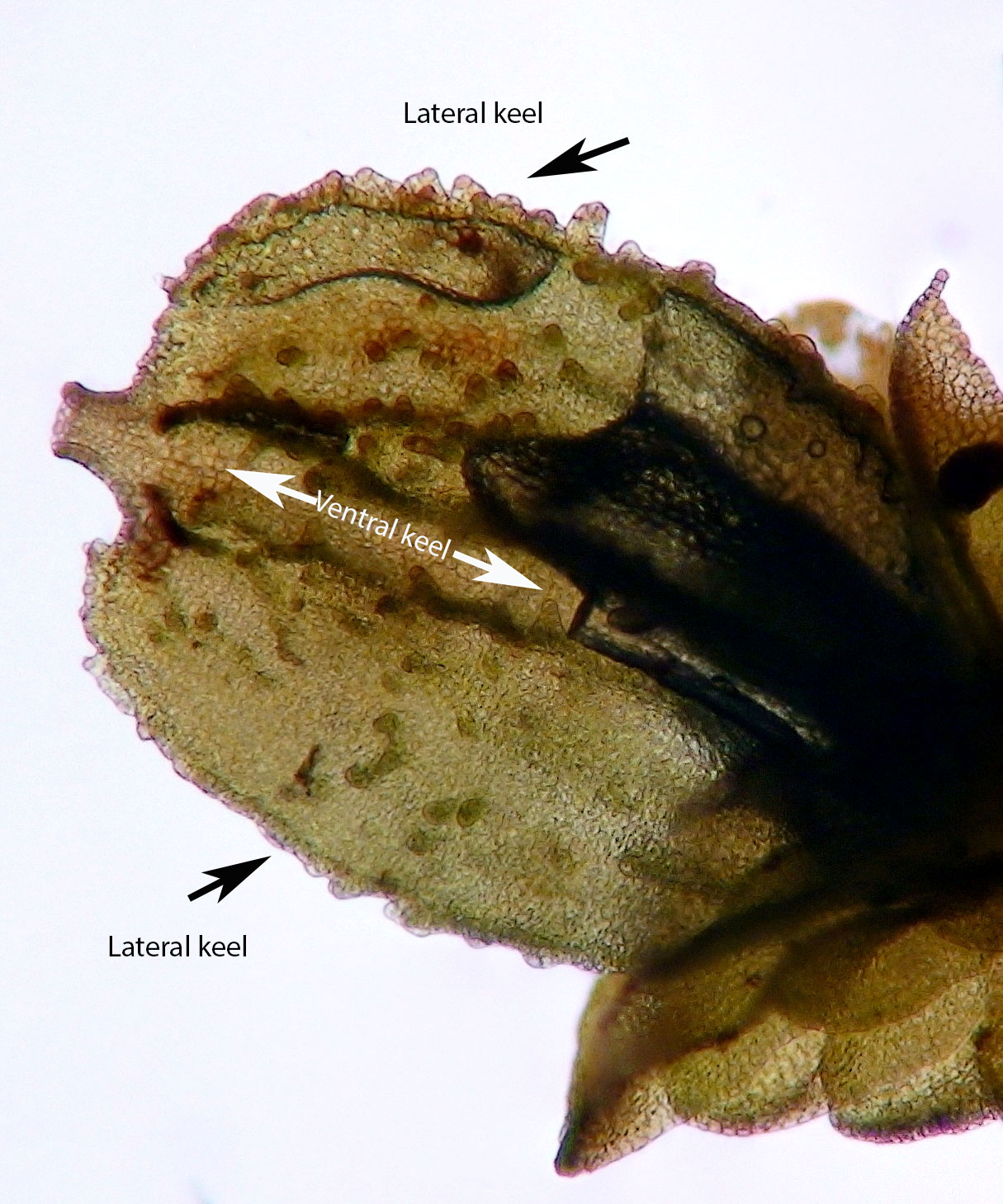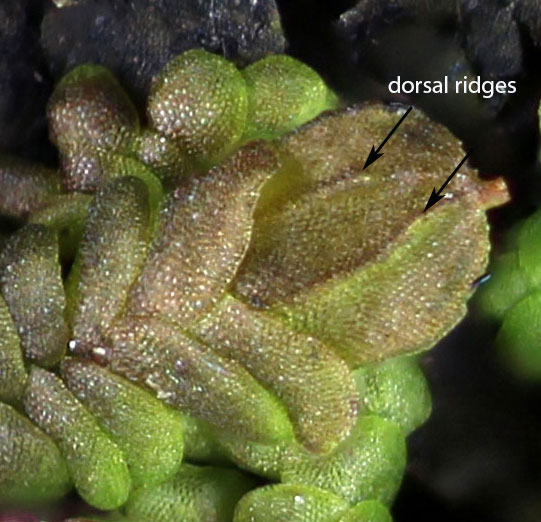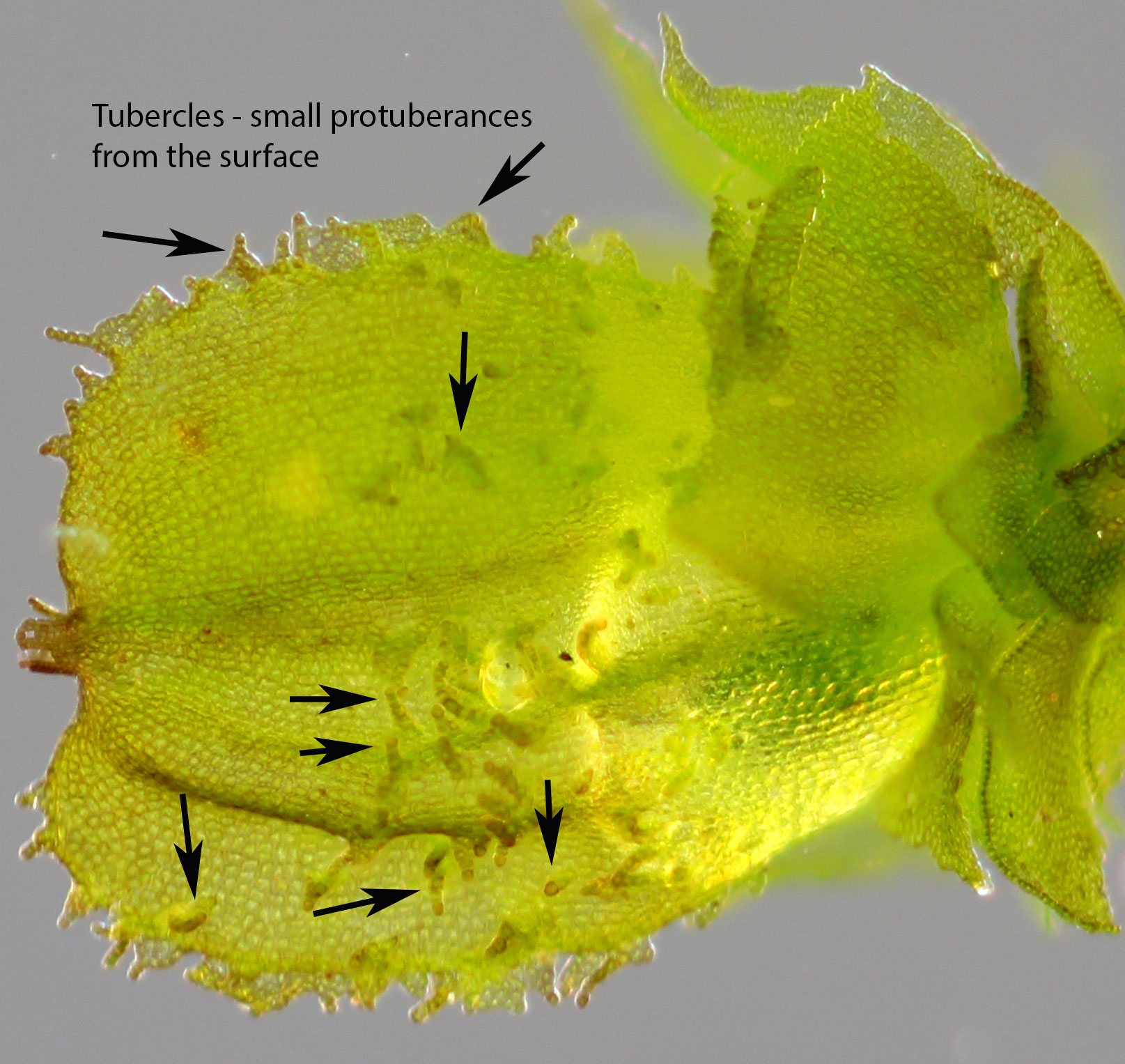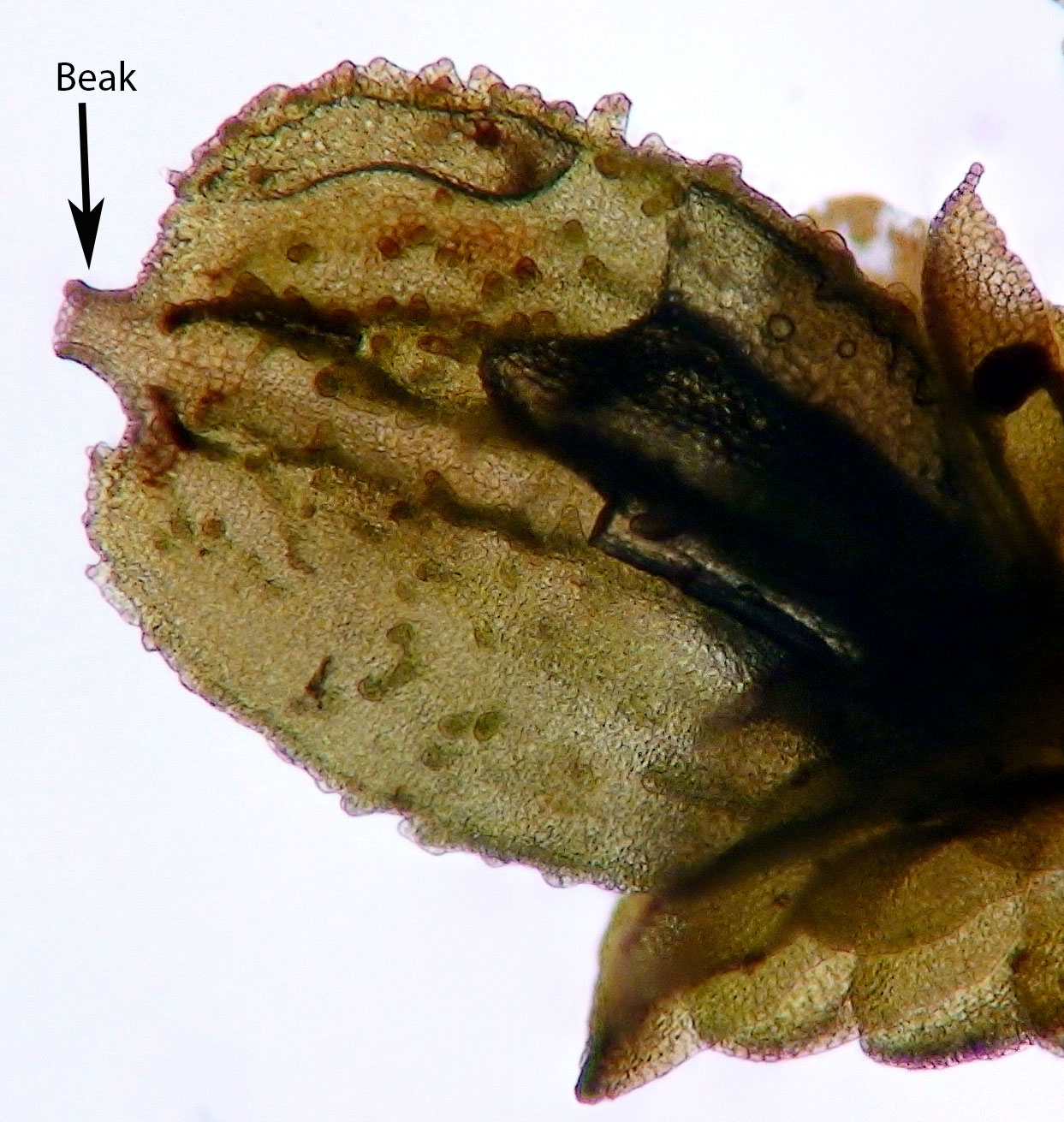Overview of the Genus Field Collecting and Lab Observations Key to species
Frullania Morphology
Leaves
There are three rows of bilobed leaves: one row of underleaves and two rows of lateral leaves. The underleaves are attached ventrally to the stem. Underleaf characters are often helpful in identifying species (e.g. width relative to the stem diameter, presence of marginal teeth). The lateral leaves (called “leaves” as opposed to the “underleaves”) are “complicate-bilobed” meaning the leaf is divided into two lobes with one lobe folded under the other. Among regional complicate-bilobed liverworts (except Scapania and Diplophyllum) the dorsal lobe is the larger lobe, called simply the “lobe.” The smaller, ventral lobe is called the “lobule.” Specimens should be turned ventral side up to observe the lobule. In Frullania the lobule is typically modified into an “inflated” or “galeate” water sac. The shape of these water sacs generally falls into one of two patterns: 1) inflated lobules longer than wide, or 2) inflated lobules about as long as wide. Each species is characterized by one pattern or the other. Of the 12 regional species, only F. asagrayana, F. caulisequa (=F. obcordata), and F. kunzei have lobules decidedly longer than wide. The mouth of the lobule may be pinched closed or open.
Some species, more than others, are prone to have lobules that are not inflated, i.e. not in the shape of a water sac. These so-called explanate lobules are typical of Frullania inflata and F. riparia, yet in some specimens of these species most lobules will be inflated. Furthermore, occasional specimens of other species of Frullania have all lobules explanate. So, the character of lobules inflated vs. explanate can’t be used blindly to distinguish taxa.
The lobe attachment to the dorsal surface of the stem (=the antical base of the leaf lobe) generally falls into one of two patterns: 1) base of lobe cordate or auriculate; 2) base of lobe rounded or truncate, not cordate. Of the 12 regional species, only F. inflata, F. oakesiana, and F. caulisequa lack the cordate or auriculate condition; in F. kunzei it may be weakly developed.
A final leaf feature to consider is the stylus, a small appendage found between the lobule and the stem. In regional species the stylus is typically small and filiform, only a few cells wide at its base. In Frullania asagrayana the stylus may be broader with one or more basal cilia. The extralimital F. stylifera, F. bolanderi, and F. cobrensis have well-formed, lamelliform styli.
Cells of the Leaf Lobe
Oil Bodies
The number of oil bodies in the cytoplasm of living, median cells of the lobe is quite useful in distinguishing some species apart from others, e.g. Frullania brittoniae (oil bodies 4-8) from members of the F. appalachiana-eboracensis-virginica complex (oil bodies 2-5); a quick count of oil bodies in several cells almost always yields results that clearly fit one pattern or the other. This is not to say however, that oil bodies in occasional cells will not fall beyond the stated ranges. Oil body number is also a useful distinction between F. inflata (o.b. 3-6) and F. stylifera (o.b. 8-16) whose geographic range in eastern North America is very likely not fully known (Atwood 2016).
Cell Walls
Cells of Frullania species generally have well developed trigones and intermediate thickenings of the longitudinal walls. The degree of development of these cell wall characters varies even within a species, yet features of the cell wall are useful aids in identifying species. For example, small trigones and absence of intermediate thickenings in the median cells of the lobe characterize F. inflata, F. kunzei, and F. oakesiana. Knowing cell wall features can give confidence when identifying sterile shoots of F. inflata apart from admixed Frullania species whose cell walls have frequent intermediate thickenings and well developed trigones. In the words of Marie Hicks (1992) when trigones and intermediate thickenings are well developed, the walls appear “wavy.” The wavy cell walls are quickly apparent at a glance in F. appalachiana-eboracensis-virginica-brittoniae-ericoides. The smooth, not wavy cell walls of the median cells of the lobe of F. inflata stand in stark contrast to the above mentioned taxa. It should be noted however, the cells of the lobules of F. inflata have wavy walls due to well-developed intermediate thickenings and strong trigones.
Perianths
The fundamental shape of the Frullania perianth in cross-section is essentially triangular with a flat dorsal face joined to two ventral faces by two lateral keels; the two ventral faces are joined to one another by a ventral keel (=postical keel). Thus the perianth is trigonous, 3-carinate, or 3-plicate (the terms are essentially synonymous). Authors have used various terms to describe the contours (shape) and surface features of the perianths of Frullania species. Schuster (1992, see pages 32, 38-39, 126-129) used the richest vocabulary employing many terms and phrases relevant to regional taxa. Many of those terms are repeated here.
Perianths are typically dorsiventrally compressed with two well-formed lateral keels and a third keel bulging ventrally. Perianths are sometimes rather inflated and then keels are poorly marked. Accessory ridges (sometimes called accessory keels or plicae if strongly developed) may occur dorsally between the lateral keels. The ventral keel may be divided into two keels, or in the words of Schuster (1992, p. 126) “ventral keel flat, 2-carinate” (as in Frullania inflata). There may be additional ridges (keels, plicae, carinae) on one or both sides of the primary ventral keel (the primary ventral keel may be lost in the modification of supplementary keels). So, in addition to the three primary keels [i.e., 2 lateral (antical) and 1 ventral (postical)], there may be supplementary keels or ridges of short or long lengths, on either the dorsal or ventral surface. The tendency for these modifications to form is often species specific. As with most other morphological features of Frullania, these characters are subject to variation and experience becomes the best guide.
The surface of the keels, ridges, and sometimes intervening tissue may be adorned with protuberances generally called tubercles, adj. tuberculate. Additional descriptive terms applied by Schuster for surface ornamentation include roughened, papillate, papillate-asperulate, aspirate, processes, echinulae, and papilliform teeth.
The apex of the perianth is abruptly constricted into a short beak. The beak offers some characters of taxonomic importance (see individual species pages).
Perianths are critically important in distinguishing taxa in the Frullania appalachiana-eboracensis-viginica complex. Once appreciated, species are often recognizable at once by their perianths as seen in situ under a dissecting microscope.
